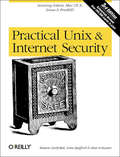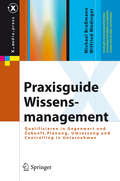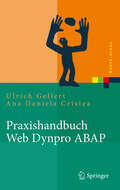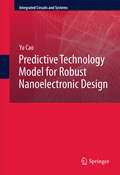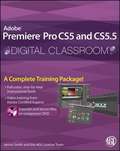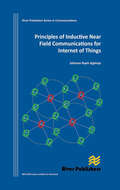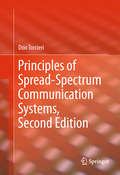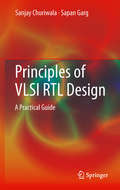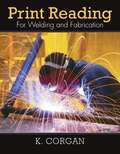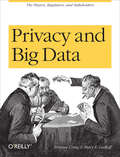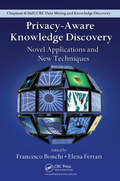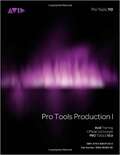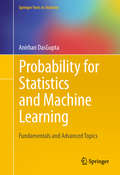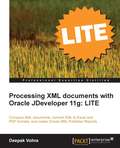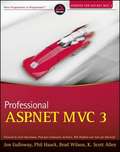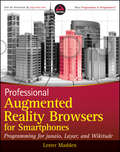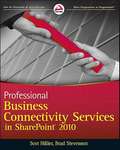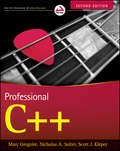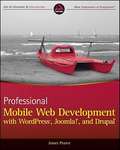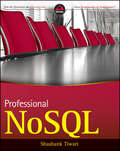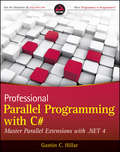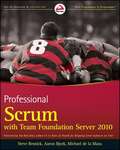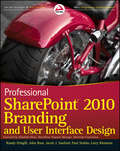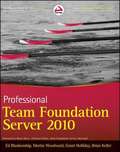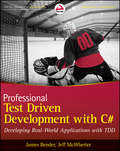- Table View
- List View
Practical UNIX and Internet Security: Securing Solaris, Mac OS X, Linux & Free BSD
by Simson Garfinkel Alan Schwartz Gene SpaffordWhen Practical Unix Security was first published more than a decade ago, it became an instant classic. Crammed with information about host security, it saved many a Unix system administrator from disaster. The second edition added much-needed Internet security coverage and doubled the size of the original volume. The third edition is a comprehensive update of this very popular book - a companion for the Unix/Linux system administrator who needs to secure his or her organization's system, networks, and web presence in an increasingly hostile world.Focusing on the four most popular Unix variants today--Solaris, Mac OS X, Linux, and FreeBSD--this book contains new information on PAM (Pluggable Authentication Modules), LDAP, SMB/Samba, anti-theft technologies, embedded systems, wireless and laptop issues, forensics, intrusion detection, chroot jails, telephone scanners and firewalls, virtual and cryptographic filesystems, WebNFS, kernel security levels, outsourcing, legal issues, new Internet protocols and cryptographic algorithms, and much more.Practical Unix & Internet Security consists of six parts:Computer security basics: introduction to security problems and solutions, Unix history and lineage, and the importance of security policies as a basic element of system security.Security building blocks: fundamentals of Unix passwords, users, groups, the Unix filesystem, cryptography, physical security, and personnel security.Network security: a detailed look at modem and dialup security, TCP/IP, securing individual network services, Sun's RPC, various host and network authentication systems (e.g., NIS, NIS+, and Kerberos), NFS and other filesystems, and the importance of secure programming.Secure operations: keeping up to date in today's changing security world, backups, defending against attacks, performing integrity management, and auditing.Handling security incidents: discovering a break-in, dealing with programmed threats and denial of service attacks, and legal aspects of computer security.Appendixes: a comprehensive security checklist and a detailed bibliography of paper and electronic references for further reading and research.Packed with 1000 pages of helpful text, scripts, checklists, tips, and warnings, this third edition remains the definitive reference for Unix administrators and anyone who cares about protecting their systems and data from today's threats.
Praxisguide Wissensmanagement
by Wilfried Mödinger Michael BroßmannPraxisorientierte Anleitung zur nutzbringenden Planung und Umsetzung von Wissensmanagement in Unternehmen. Sie beschreibt Wissensvermittlung mit Hilfe von Printmedien, Computer Based Training (CBT), Web Based Training (WBT), interaktivem Business TV, e-Training und Lernplattformen (Learning-Management-Systeme, LMS). So ermittelt sie den konkreten Beitrag dieser Verfahren in der Wertschöpfungskette von Unternehmen. Das Buch stellt den Return-on-Investment (ROI) des Wissensmanagements mit Hilfe einer dafür entwickelten Score Card dar. Plus: Perspektiven für die Zukunft durch Social Computing und Web 2.0-Anwendungen (Weblog, Wiki etc.).
Praxishandbuch Web Dynpro ABAP
by Ulrich Gellert Ana Daniela CristeaWeb Dynpro ABAP ermöglicht die Web-Programmierung von Anwendungen, die durch SAP-Systeme verbunden sind. Der Band bietet eine Schritt-für-Schritt-Einführung in Web Dynpro ABAP. Leser sollen durch das Erarbeiten der praxisbasierten Beispiele in die Lage versetzt werden, die verschiedenen Komponenten dieser Web-Programmierung zu verstehen und anzuwenden. Die Autoren vermitteln auch den Zusammenhang zwischen Web Dynpro ABAP und anderen SAP NetWeaver-Elementen wie z. B. ABAP Dictionary, Autorisierung und Portal Interaction.
Predictive Technology Model for Robust Nanoelectronic Design
by Yu CaoPredictive Technology Model for Robust Nanoelectronic Design explains many of the technical mysteries behind the Predictive Technology Model (PTM) that has been adopted worldwide in explorative design research. Through physical derivation and technology extrapolation, PTM is the de-factor device model used in electronic design. This work explains the systematic model development and provides a guide to robust design practice in the presence of variability and reliability issues. Having interacted with multiple leading semiconductor companies and university research teams, the author brings a state-of-the-art perspective on technology scaling to this work and shares insights gained in the practices of device modeling.
Premiere Pro CS5 and CS5.5 Digital Classroom
by Agi Creative Team Jerron SmithA book-and-DVD training package so you can learn Premiere Pro at your own pacePremiere Pro is a powerful, timeline-based video editing software, and this personal training course uses a full-color book plus video tutorials on DVD to teach you how to use all its features. Fifteen self-paced lessons encourage you to discover the creative possibilities that Adobe' s Premiere Pro presents. Step-by-step directions, lesson files, and an instructional video demonstrate the many exciting features of Premiere Pro. You can learn from leading instructors, and do it at your own pace.Premiere Pro is an advanced video-editing program available at an affordable price; this book-and-DVD package offers step-by-step training on its abilitiesPresents 15 lessons in full color, supported by video tutorials and lesson files on the DVD, all of which allow you to work at your own paceDemonstrates how to work with a variety of popular film styles featuring the latest in editing techniques at the highest quality possiblePremiere Pro Digital Classroom is like having your own personal instructor to teach you Premiere Pro right in your own home or office.
Principles of Inductive Near Field Communications for Internet of Things
by Johnson I. AgbinyaNear field communication devices and the emerging field of Internet of things require efficient short range communication techniques. Classical telecommunication theory however has so far focused on radiating electromagnetic signals which is more suited to terrestrial communication systems. Over the last decade however considerable research and applications of inductive methods have emerged as innovative approaches for secure short range communications by changing the paradigm of an established model of electromagnetic communications. We have witnessed the emergence of embedded inductive medical devices, magneto-inductive waveguides, inductive pots and cooking devices, magneto-inductive sensors, wireless power transfer, inductive hearing aids and the emerging inductive point-to-point communication specifically termed near-field communication (NFC) as used in mobile phones and payment cards to name a few. While there exist a large set of distributed methods and algorithms detailing the design and performances of such applications, a significant gap is observed as a lack of detailed collection of the methods in one place which could be easily understood and used quickly by someone seeking to apply the methods.In this book this missing gap is filled with the required details and the theory of near field communication systems including both the radiating and reactive (energy coupling) near-field systems in addition to the well known far field radiation techniques. The book details the fundamental expressions and design methods which facilitate the creation of near field devices and equipment including embedded biomedical implants. The book contains recent advances in inductive communications, performance, limitations and a collection of applications. It also lays a strong foundation for the application of inductive methods for creating Internet of Things systems.
Principles of Spread-Spectrum Communication Systems, Second Edition
by Don TorrieriThis book provides a concise but lucid explanation of the fundamentals of spread-spectrum systems with an emphasis on theoretical principles. Throughout the book, learning is facilitated by many new or streamlined derivations of the classical theory. Problems at the end of each chapter are intended to assist readers in consolidating their knowledge and to provide practice in analytical techniques. The choice of specific topics is tempered by the author’s judgment of their practical significance and interest to both researchers and system designers. The evolution of spread spectrum communication systems and the prominence of new mathematical methods in their design provided the motivation to undertake this new edition of the book. This edition is intended to enable readers to understand the current state-of-the-art in this field. More than 20 percent of the material in this edition is new, including a chapter on systems with iterative channel estimation, and the remainder of the material has been thoroughly revised.
Principles of VLSI RTL Design
by Sapan Garg Sanjay ChuriwalaSince register transfer level (RTL) design is less about being a bright engineer, and more about knowing the downstream implications of your work, this book explains the impact of design decisions taken that may give rise later in the product lifecycle to issues related to testability, data synchronization across clock domains, synthesizability, power consumption, routability, etc., all which are a function of the way the RTL was originally written. Readers will benefit from a highly practical approach to the fundamentals of these topics, and will be given clear guidance regarding necessary safeguards to observe during RTL design.
Print Reading for Welding and Fabrication
by Kevin CorganPRINT READING FOR WELDING AND FABRICATION, First Edition, offers students a simple, logical, easy-to-understand path to reading and understanding the drawings that are most commonly found in the welding and fabrication industries. Each chapter clearly presents objectives and key terms, and offers practical exercises. Each chapter also provides a supplement with bite-size, easy-to-follow explanations of the mathematics that welders need in order to successfully interpret prints. Throughout, the author emphasizes the codes, standards, and industrial practices students will be most likely to encounter. Concepts and terminology from the American Welding Society (AWS) and The Society of Mechanical Engineers (ASME) are used throughout.
Privacy and Big Data: The Players, Regulators, and Stakeholders
by Mary E. Ludloff Terence CraigMuch of what constitutes Big Data is information about us. Through our online activities, we leave an easy-to-follow trail of digital footprints that reveal who we are, what we buy, where we go, and much more. This eye-opening book explores the raging privacy debate over the use of personal data, with one undeniable conclusion: once data's been collected, we have absolutely no control over who uses it or how it is used.Personal data is the hottest commodity on the market today—truly more valuable than gold. We are the asset that every company, industry, non-profit, and government wants. Privacy and Big Data introduces you to the players in the personal data game, and explains the stark differences in how the U.S., Europe, and the rest of the world approach the privacy issue.You'll learn about:Collectors: social networking titans that collect, share, and sell user dataUsers: marketing organizations, government agencies, and many othersData markets: companies that aggregate and sell datasets to anyoneRegulators: governments with one policy for commercial data use, and another for providing security
Privacy-Aware Knowledge Discovery: Novel Applications and New Techniques (Chapman & Hall/CRC Data Mining and Knowledge Discovery Series)
by Francesco Bonchi Elena FerrariCovering research at the frontier of this field, Privacy-Aware Knowledge Discovery: Novel Applications and New Techniques presents state-of-the-art privacy-preserving data mining techniques for application domains, such as medicine and social networks, that face the increasing heterogeneity and complexity of new forms of data. Renowned authorities
Pro Tools Production I for Pro Tools 10.0
by Avid DigidesignPro Tools 110, Official Courseware, Pro Tools Production I
Probability for Statistics and Machine Learning
by Anirban DasguptaThis book provides a versatile and lucid treatment of classic as well as modern probability theory, while integrating them with core topics in statistical theory and also some key tools in machine learning. It is written in an extremely accessible style, with elaborate motivating discussions and numerous worked out examples and exercises. The book has 20 chapters on a wide range of topics, 423 worked out examples, and 808 exercises. It is unique in its unification of probability and statistics, its coverage and its superb exercise sets, detailed bibliography, and in its substantive treatment of many topics of current importance. This book can be used as a text for a year long graduate course in statistics, computer science, or mathematics, for self-study, and as an invaluable research reference on probabiliity and its applications. Particularly worth mentioning are the treatments of distribution theory, asymptotics, simulation and Markov Chain Monte Carlo, Markov chains and martingales, Gaussian processes, VC theory, probability metrics, large deviations, bootstrap, the EM algorithm, confidence intervals, maximum likelihood and Bayes estimates, exponential families, kernels, and Hilbert spaces, and a self contained complete review of univariate probability.
Processing XML documents with Oracle JDeveloper 11g: LITE
by Deepak VohraEmploying a comprehensive tutorial-based approach, this easy-to-follow book shows the reader various means of processing XML documents using the power of Oracle's JDeveloper 11g. The material has been carefully selected from Packt's fuller 384 page Processing XML documents with Oracle JDeveloper 11g. This book is for newcomer and intermediate Java developers who want to work with XML documents using JDeveloper 11g. No previous knowledge of JDeveloper is assumed but the reader will need to be comfortable in XML and Java environments.
Professional ASP.NET MVC 3
by K. Scott Allen Jon Galloway Phil Haack Brad WilsonNew edition of the top book on MVC from the top ASP. NET experts at Microsoft! MVC 3. 0 is the latest update to Microsoft's Model-View-Controller technology, which enables developers to build dynamic, data-driven web sites. This in-depth book shows you step by step how to use MVC 3. 0. Written by top ASP. NET MVC experts at Microsoft, the latest edition of this popular book covers new and updated features such as the new View engine, Razor, NuGet, and much more. The book's practical tutorials reinforce concepts and allow you create real-world applications. Topics include controllers and actions, forms and HTML helpers, Ajax, unit testing, and much more. Shows developers and programmers how to use ASP. NET MVC 3. 0, Microsoft's new version of its Model-View-Controller technology for developing dynamic, data-driven web sites Features an expert author team?all are members of Microsoft's ASP. NET team Uses a step-by-step approach to explain all major features and functionalities and provides practical tutorials to allow you to create real-world applications Goes into theory as well as practical application and covers such topics as Razor, NuGet (PowerShell inside Visual Studio 2010), and new layout features Move your development skills to the next level with MVC 3. 0 and Professional ASP. NET MVC 3. 0.
Professional Augmented Reality Browsers for Smartphones
by Lester MaddenCreate amazing mobile augmented reality apps with junaio, Layar, and Wikitude!Professional Augmented Reality Browsers for Smartphones guides you through creating your own augmented reality apps for the iPhone, Android, Symbian, and bada platforms, featuring fully workable and downloadable source code. You will learn important techniques through hands-on applications, and you will build on those skills as the book progresses.Professional Augmented Reality Browsers for Smartphones:Describes how to use the latitude/longitude coordinate system to build location-aware solutions and tells where to get POIs for your own augmented reality applicationsDetails the leading augmented reality platforms and highlights the best applicationsCovers development for the leading augmented reality browser platforms: Wikitude, Layar, and junaioShows how to build cross-platform location-aware content (Android, iPhone, Symbian, and bada) to display POIs directly in camera viewIncludes tutorials for building 2D and 3D content, storing content in databases, and triggering actions when users reach specific locationswrox.comProgrammer ForumsJoin our Programmer to Programmer forums to ask and answer programming questions about this book, join discussions on the hottest topics in the industry, and connect with fellow programmers from around the world.Code DownloadsTake advantage of free code samples from this book, as well as code samples from hundreds of other books, all ready to use.Read MoreFind articles, ebooks, sample chapters, and tables of contents for hundreds of books, and more reference resources on programming topics that matter to you.Wrox Professional guides are planned and written by working programmers to meet the real-world needs of programmers, developers, and IT professionals. Focused and relevant, they address the issues technology professionals face every day. They provide examples, practical solutions, and expert education in new technologies, all designed to help programmers do a better job.
Professional Business Connectivity Services in SharePoint® 2010
by Scot P. Hillier Brad StevensonComprehensive coverage on Business Connectivity Services within SharePoint 2010 As Microsoft's new multipurpose portal technology, Business Connectivity Services (BCS) is a brand new way for SharePoint users to seamlessly access and integrate data from any application or databases within SharePoint 2010. With this in-depth guide, a team of SharePoint experts walks you through the features of the new BCS, including the ability for users to view and modify the data from SharePoint 2010 with BCS. You'll explore how to use BCS, deploy solutions, create external content types and lists, create . NET host connectors, and more. Business Connectivity Services (BCS) allows you to seamlessly access and integrate data from any application or databases within SharePoint 2010 Demonstrates how to create BCS solutions with the SharePoint Designer in SharePoint 2010 and Office Provides a clear overview of the BCS API Addresses creating external content types and lists Explains how to develop search-based solutions with BCS Professional Business Connectivity Services in SharePoint 2010 provides you with thorough coverage on this new multipurpose portal technology.
Professional C++
by Nicholas A. Solter Marc Gregoire Scott J. KleperEssential reading for experienced developers who are determined to master the latest release of C++ Although C++ is often the language of choice from game programming to major commercial software applications, it is also one of the most difficult to master. With this no-nonsense book, you will learn to conquer the latest release of C++. The author deciphers little-known features of C++, shares detailed code examples that you can then plug into your own code, and reveals the significant changes to C++ that accompany the latest release. You'll discover how to design and build applications that solve real-world problems and then implement the solution using the full capabilities of the language. Appeals to experienced developers who are looking for a higher level of learning Drills down the extensive changes to the latest C++ standard, C++11, including enhancements made to run-time performance, standard library, language usability, and core language Zeroes in on explaining the more poorly understood elements of the C++ feature set and addresses common pitfalls to avoid Includes case studies that feature extensive, working code that has been tested on Windows and Linux platforms Intertwines text with useful tips, tricks, and workarounds Packed with best practices for programming, testing, and debugging applications, this book is vital for taking your C++ skills to the next level.
Professional Mobile Web Development with WordPress, Joomla! and Drupal
by James PearceHow to develop powerful mobile Web sites using popular content management systems (CMS)Mobile is the hottest thing going--and developing content for mobile devices and browsers is even hotter than that. This book is your guide to it all--how to design, build, and deploy sites, blogs and services that will work brilliantly for mobile users. You'll learn about the state-of-the-art of mobile web development, the tools available to use, and the best practices for creating compelling mobile user interfaces. Then, using the most popular content management systems, WordPress, Joomla!, and Drupal, you'll learn how to building world-class mobile web sites from existing platforms and content.. The book walks you through each platform, including how to use third-party plug-ins and themes, explains the strategies for writing your own logic, how to switch between mobile and desktop, and much more.Provides a technical review of the mobile landscape and acquaints you with a range of mobile devices and networksCovers topics common to all platforms, including site topologies, switching between mobile and desktop, common user interface patterns, and moreWalks you through each content management platform--WordPress, Joomla!, and Drupal--first focusing on standard plug-ins and themes and then exploring advanced techniques for writing your own themes or logicExplains the best practices for testing, deploying, and integrating a mobile web siteAlso explores analytics, m-commerce, and SEO techniques for mobileGet ahead of the the mobile web development curve with this professional and in-depth reference guide!
Professional NoSQL
by Shashank TiwariA hands-on guide to leveraging NoSQL databases NoSQL databases are an efficient and powerful tool for storing and manipulating vast quantities of data. Most NoSQL databases scale well as data grows. In addition, they are often malleable and flexible enough to accommodate semi-structured and sparse data sets. This comprehensive hands-on guide presents fundamental concepts and practical solutions for getting you ready to use NoSQL databases. Expert author Shashank Tiwari begins with a helpful introduction on the subject of NoSQL, explains its characteristics and typical uses, and looks at where it fits in the application stack. Unique insights help you choose which NoSQL solutions are best for solving your specific data storage needs. Professional NoSQL: Demystifies the concepts that relate to NoSQL databases, including column-family oriented stores, key/value databases, and document databases. Delves into installing and configuring a number of NoSQL products and the Hadoop family of products. Explains ways of storing, accessing, and querying data in NoSQL databases through examples that use MongoDB, HBase, Cassandra, Redis, CouchDB, Google App Engine Datastore and more. Looks at architecture and internals. Provides guidelines for optimal usage, performance tuning, and scalable configurations. Presents a number of tools and utilities relating to NoSQL, distributed platforms, and scalable processing, including Hive, Pig, RRDtool, Nagios, and more.
Professional Parallel Programming with C#
by Gastón HillarExpert guidance for those programming today's dual-core processors PCs As PC processors explode from one or two to now eight processors, there is an urgent need for programmers to master concurrent programming. This book dives deep into the latest technologies available to programmers for creating professional parallel applications using C#, . NET 4, and Visual Studio 2010. The book covers task-based programming, coordination data structures, PLINQ, thread pools, asynchronous programming model, and more. It also teaches other parallel programming techniques, such as SIMD and vectorization. Teaches programmers professional-level, task-based, parallel programming with C#, . NET 4, and Visual Studio 2010 Covers concurrent collections, coordinated data structures, PLINQ, thread pools, asynchronous programming model, Visual Studio 2010 debugging, and parallel testing and tuning Explores vectorization, SIMD instructions, and additional parallel libraries Master the tools and technology you need to develop thread-safe concurrent applications for multi-core systems, with Professional Parallel Programming with C#.
Professional Scrum with Team Foundation Server 2010
by Aaron Bjork Steve Resnick Michael de la MazaProfessional guidance on using Microsoft's Visual Studio toolset for agile project managementFocusing on both process and results, this professional guide offers a practical approach to running agile software projects using Visual Studio's project management templates and tools. You'll first get a thorough overview of the interaction between traditional, scrum-based agile development techniques and the Microsoft Soutions Framework, before drilling down into the detail. The book covers tools, best practices, key templates, key data, team and process models, necessary tracking assets--and a host of other project challenges, such as project communication, organization, and budgets.Shows how to use Microsoft's agile Visual Studio toolset for agile project management Written by leading experts from Microsoft and industry, this is an authoritative guide to agile development for all Microsoft-based projectsTeaches basic concepts through best practices for delivering great software on time Covers the interaction of traditional, scrum-based agile development techniques and the Microsoft Solutions Framework Focuses on what must be in place to keep a project on track, including team models, process models, detailed tracking assets, and more Professional Scrum with Team foundation Server 2010 combines theory with practical experience to help experienced software project managers and developers ship reliable software on time.
Professional SharePoint 2010 Branding and User Interface Design
by John Ross Paul Stubbs Randy Drisgill Jacob J. Sanford Larry RiemannA must have guide for creating engaging and usable SharePoint 2010 branding With SharePoint 2010, Microsoft has provided a more robust environment for creating collaboration and content management sites that rival any of the popular websites on the internet. Creating a branded SharePoint site involves understanding both traditional web design techniques as well as topics that are typically reserved for developers. This book bridges that gap by not only providing expert guidance for creating beautiful public facing and internal intranet sites but it also addresses the needs of those readers that only want to understand the basics enough to apply some style to their sites. Things like creative design, the experience visitors have navigating your user interface, ease of use--these are all important branding considerations and not always intuitive. This unique book from a team of SharePoint branding experts lays it all out. Whether you want to make SharePoint look completely different or just make minor design changes, this expert guide will provide tips, techniques, and insights to get the job done.
Professional Team Foundation Server 2010
by Martin Woodward Brian Keller Grant Holliday Ed BlankenshipAuthoritative guide to TFS 2010 from a dream team of Microsoft insiders and MVPs!Microsoft Visual Studio Team Foundation Server (TFS) has evolved until it is now an essential tool for Microsoft?s Application Lifestyle Management suite of productivity tools, enabling collaboration within and among software development teams. By 2011, TFS will replace Microsoft?s leading source control system, VisualSourceSafe, resulting in an even greater demand for information about it. Professional Team Foundation Server 2010, written by an accomplished team of Microsoft insiders and Microsoft MVPs, provides the thorough, step-by-step instruction you need to use TFS 2010 efficiently?so you can more effectively manage and deliver software products in an enterprise. Provides a broad overview of Team Foundation Server for developers, software project managers, testers, business analysts, and others wanting to?learn how to use TFSGives TFS administrators the tools they need to efficiently monitor and manage the TFS environmentCovers core TFS functions including project management, work item tracking, version control, test case management, build automation, reporting, and more??Explains extensibility options and how to write extensions for TFS 2010Helps certification candidates prepare for the Microsoft Team Foundation Server 2010 certification exam (Exam 70-512)The clear, programmer-to-programmer Wrox style of Professional Team Foundation Server 2010 will soon have you thoroughly up to speed.
Professional Test Driven Development with C#: Developing Real World Applications with TDD
by Jeff Mcwherter James BenderHands-on guidance to creating great test-driven development practiceTest-driven development (TDD) practice helps developers recognize a well-designed application, and encourages writing a test before writing the functionality that needs to be implemented. This hands-on guide provides invaluable insight for creating successful test-driven development processes. With source code and examples featured in both C# and .NET, the book walks you through the TDD methodology and shows how it is applied to a real-world application. You'll witness the application built from scratch and details each step that is involved in the development, as well as any problems that were encountered and the solutions that were applied.Clarifies the motivation behind test-driven development (TDD), what it is, and how it worksReviews the various steps involved in developing an application and the testing that is involved prior to implementing the functionalityDiscusses unit testing and refactoringProfessional Test-Driven Development with C# shows you how to create great TDD processes right away.
